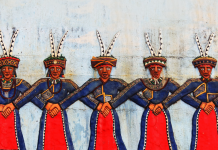Batik – one of Indonesia’s age-old treasures and on UNESCO’s list of Masterpieces of the Oral and Intangible Heritage of Humanity – has been catapulted into the modern era
Text Tony Sugiarta
One of Asia’s most recognisable and labour-intensive textile production techniques is currently undergoing a major technology upgrade. The faculties of Art and Design and Industrial Technology (Engineering Physics department) of the Bandung Institute of Technology (ITB) are currently developing a photonic batik machine that will use ultraviolet light emitting diodes (UV LEDs) to colour the cloth. The machine’s UV-LED colour activator will expose the cloth to consistent lighting, resulting in brighter colours and creating an even dyeing effect through the entire piece. Unlike traditional methods, it allows artisans to produce batik even in poor weather or at night. The innovation will help increase batik production capacity, says Komarudin Kodiya, a faculty member at ITB and owner of batik production house Batik Komar.

Traditionally, batik cloth is laid out in the sun to dry, where natural UV radiation activates dye compounds in the cloth. In tropical countries like Indonesia, this means production may stop during the rainy season. By using LEDs, the machine – which comprises an adjustable wooden frame and cooling fans – consumes less power and creates minimal heat, keeping the wax patterns intact. Unlike with natural sunlight, artisans are also able to keep the radiation strength consistent across the cloth. Other recent innovations include jBatik, a design software that quickly creates batik motifs using mathematical formulas, and low-power electric stoves with built-in vessels that replace the toxic kerosene-based stoves traditionally used to keep wax warm. Wax pens are also available on the market.
Related: Who Was Sylvia?
How is batik made?
Batik’s name might come from the Bahasa word ambatik (meaning “a cloth with little dots”). Batik artisans create a pattern by repeatedly applying wax to a cloth, colouring it, and then removing the wax. Motifs and colours represent socioeconomic status, symbols and cultural identity, and the cloth is used in many rituals like births, coming-of-age ceremonies, marriage, and death. Traditionally, batik cloth is dyed using natural compounds extracted from minerals, animals, and plants, such as the leaves, bark, stem and roots of the trees Indigofera tinctoria L., Ceriops candolleana Arn. and Morinda citrifolia. These are soaked in an extraction solution until the water is coloured. Finally, the dyed cloth is laid out in the sun to dry, where the UV radiation activates the dye compounds. Not all dyes require sunning, but most do.
Related: Spiritual Skin
Today, dye vats are set up in manufacturing plants that condense the extraction solution continuously. Scientists can adjust the pH, add natural dye fixing agents (such as limestone paste and alum), and transform extracts into convenient powder or paste form. An alternative is synthetic dye, which treats the cloth with chemicals, but produces toxic waste, which has led to a rise in demand for eco-friendly batik in recent years.
Related: Escape to Lombok
For more stories and photographs from this issue, see Asian Geographic Issue 129, 2018




![The Road to Independence: Malaya’s Battle Against Communism [1948-1960]](https://asiangeo.com/wp-content/uploads/2021/07/WhatsApp-Image-2021-07-26-at-11.07.56-AM-218x150.jpeg)






